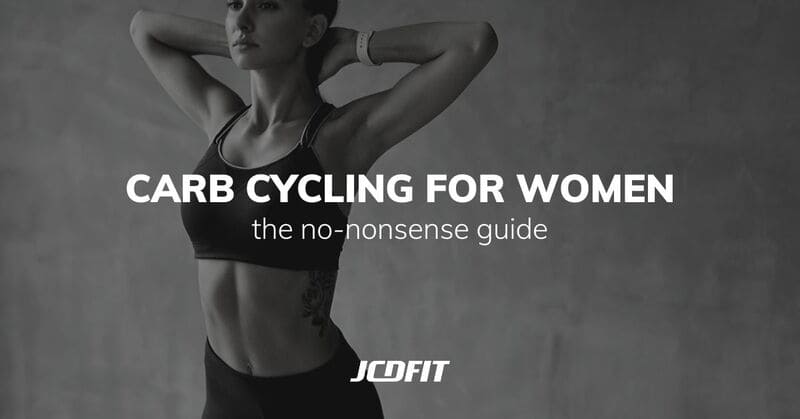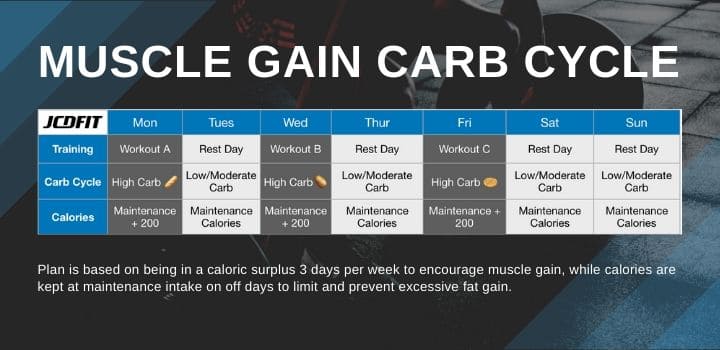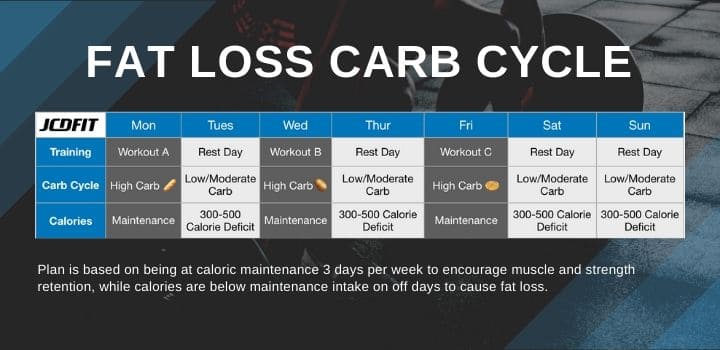
Carbs are good. Carbs are bad. Keto is in, carbs are out. Sugar is poison, fat is nourishing. You’ve probably read it all at this point and if you’re confused, I get it.
But let me tell you this: carbs are good for you and if you want to maximize your efforts in the gym, carb cycling just might be what you’re looking for…
So, if you’re a woman and you want to build muscle, lose fat, and do it in the most efficient and effective way possible, let me introduce you to a dietary strategy called carb cycling.
What Is Carb Cycling?
First of all, here is what it’s not.
Carb cycling isn’t:
- Overly complicated
- Severely limiting or restrictive
Oh, and it isn’t a magical approach to diet that is going to work way better than everything else. All the rules apply and calories still count. However, if you have body composition goals like less fat, more muscle, a bigger booty, or all of the above, then it’s one of the best methods you can use.
So… let’s get into it.
Note: I will make this article concise and useful, mostly focusing on the highlights of how women can use carb cycling. If you want an in-depth look at how how this dietary strategy works, check out my comprehensive guide on carb cycling.
Carb cycling is a method of eating more carbohydrates for a sustained period followed by a period of eating fewer carbohydrates. And in this example, a sustained period is usually one or two days long.
Cliffs version:
Some days you’ll eat lots of carbohydrates and some days you’ll eat a lot less or very little to none. And since carb cycling differs from the standard approach to diet, where you eat similar amounts of food daily, you’ll want to be more mindful of how you use this approach.
So if you aim to utilize this method for your goals of fat loss, more muscle, or better performance in the gym, you must do it properly.
While carb cycling is generally a flexible dieting approach, you’ll want to remember that there is no single right or wrong way to go about this. As an individual, your carbohydrate and energy needs will be different from others. Some people eat a higher carb diet every single day and some eat a lower carb diet. Some cycle their carbs, some don’t.
Regardless of your goals, whether they be fat loss, muscle gain, improved performance, or maintenance, you can adopt a carb cycling approach, and that’s what this guide is for.
Why You Might Choose Carb Cycling
When most people choose to use carb cycling, it’s because they want to maximize their performance all the while minimizing their accrual of body fat and loss of muscle mass.
You see, if you have a goal of losing fat, you must follow a dietary deficit. I cover all of this in my fat loss guide. Using carb cycling for at loss allows you to lose the most fat possible without losing muscle during a dieting period.
Now if you have a goal of gaining muscle mass, especially if you want to grow your glutes, you can use carb cycling to help you gain muscle without gaining a lot of excess fat in the process.
The reason we think this works is because carb cycling attempts to manipulate glycogen stores in a strategic manner by topping up the body’s stored carbs to replace what’s been used up for exercise.
A quick example to help illustrate this point is the high carb meals runners would often have the night before their race the next day. It’s common for runners to consume lots of pasta, bread, juice, and other carbohydrates the evening before a race to ensure their glycogen stores are full.
This way, they would have plenty of stored carbohydrates (glycogen) for their race the following day. Now you must know the following: If you’re weight training 3-5 days per week, you don’t need to be stuffing yourself silly with pasta, bagels, and juice the night before a gym session. But strategically having more carbohydrates around your training days can help you significantly.
So what does this look like?
Goal-Oriented Carb Cycling Examples
In this section, I’m going to outline what carb cycling looks like based on any particular goal you may have. For this case, we’ll use muscle gain and fat loss as the main goals.
Remember, these outlines are only examples. You don’t have to follow them as-written and it’s encouraged you only view these as a starting point.
Of course, it can become far more complicated than what I’ve laid out, but I don’t recommend you do such a thing because hey… why make anything harder than it needs to be?
Below you’ll see some charts I’ve made for how carb cycling works and how it would be set up for a particular goal. To keep these examples as simple as possible, we’ll be using a 3-day training plan as the basis for showing you how this works.
Before we get into this, I’m going to be referencing your maintenance calorie intake which is the total calories required to maintain your body weight at your given activity level.
Carb Cycling For Muscle Gain

If you want to gain muscle, one thing is absolutely certain: you must be in a caloric surplus. Good thing is that I’ve written about the most ideal caloric surplus for women.
And here’s what you need to know. Generally, women should eat 200-300 calories above their maintenance intake only on their training days and keep their calories around maintenance on their days off of training.
This helps prevent fat gain while still allowing you to recover properly from hard weight training.
With carb cycling for muscle gain, you have high carb days when you train, and moderate to low carbs when you’re not working out.
Carb Cycling For Fat Loss

If you want to lose fat, one thing is absolutely certain: you must be in a caloric deficit. Good thing is that I’ve written about that as well as energy expenditure to help you understand how this works.
And here’s what you need to know. Generally, women should eat around their maintenance intake only on their training days and create their caloric deficit on their days off of training.
This helps you lose fat while still getting enough food on your training days to encourage strength gains and fuels recovery from hard workouts..
With carb cycling for fat loss, you have high carb days when you train, and moderate to low carbs when you’re not working out.
How Do You Determine High And Moderate/Low Carb Intake?
It’s all relative to your current maintenance calorie needs.
And this starts by determining your macronutrient needs. There are a few ways to do this but if you want to save time, you can use my calorie intake calculator (which also spits out some starting macros, too).
For the most part, we want you to get around .8 to 1 gram of protein per pound of body weight. Then we want you getting somewhere around 20-30% of your calories from fat. From there, all we have left are carbohydrates.
So your total carbohydrate intake will be relative to your unique needs. Pretty great right?
Here’s a really quick example using my calorie intake calculator for a woman weighing 150 pounds who wants to focus on fat loss using a carb cycling plan. In fact, this works incredibly well with my booty workout plan because it has you training in the gym 3 days per week.
Her stats:
Age: 28
Weight: 150
Height: 5’5”
Activity: Moderately active (trains 3 days per week, walking on her off days)
Estimated maintenance intake: ~2,200 calories
On her training days, her calorie intake would be as follows:
2,200 calories
150g protein
285g carbs
50g fat
On her off days (with a 500 calorie deficit), her calorie intake would be:
1,700 calories
150g protein
100g carbs
80g fat
And that’s it — it’s the basis of a smart, easy-to-use, carb cycling protocol.
One more thing…
Weight Training + Carb Cycling = Amazing Results
If you’ve read anything of mine, you know I’m all about strength training as the main mode of exercise. So everything here will be in the context of you following a solid training program to give you leaner, more toned body. Cardio is totally fine, but it’s not the main focus.
BTW, if you’re not sure about which type of program to follow, I have you covered. Check out HOT BOD if you want a for-women-only approach to training or check out The Results Crew if you want everything HOT BOD has to offer + some extra guidance and accountability along the way.
Step 1: Follow a 3 or 4 day weight training program.
I’m partial to weight training because it helps build your body to look more athletic overall.
Step 2: Determine your calorie intake needs.
The easiest way is to use my calorie intake calculator. If you plug in your stats, it’ll spit out some numbers for you to get started with.
Step 3: Track your progress.
Track your sets and reps at the gym. Track your nutrition. See my macro counting guide for more insight here.
Here are some questions I got about this topic on my Instagram.
Q: Are there benefits to carb cycling over eating the same diet daily?
Yes. There are a few but how helpful carb cycling is will mostly be based on your individual needs. For instance, if the thought of eating a different intake every other day of the week makes you anxious, carb cycling might not be for you.
However, if you want to pay attention to the details and maximize your recovery and potential progress in the gym, carb cycling can only help when done properly.
Q: How can I eat to intentionally target areas of my body for weight loss?
Unfortunately, there is no way to ‘spot reduce’ by eating certain foods. It’s a common myth that there are so-called fat burning foods but all food contains calories, and the only way to lose weight is by reducing calories.
So the idea that you should eat certain foods to burn fat defies logic and is just a marketing ploy for dipshits on the internet who want to drain your wallet.
